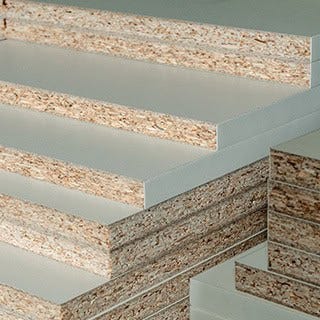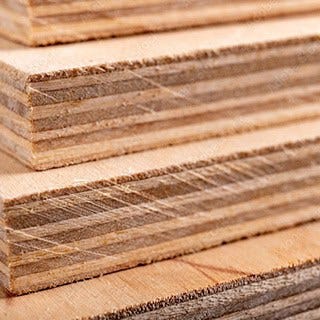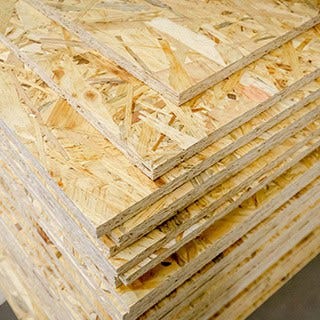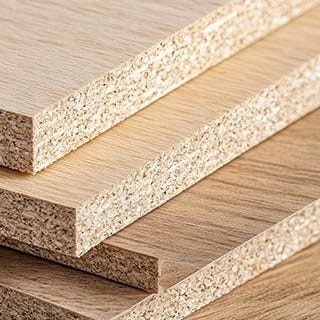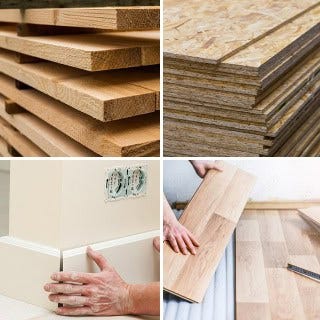The Acoustic Advantages of OSB Board: Enhancing Sound Control in Modern Designs
As open floor plans gain popularity, managing noise transmission becomes a key design concern. Oriented strand board (OSB), also known as sterling board, delivers useful sound absorbing and blocking capacities. It can enhance acoustics, in addition to its structural capabilities.
From residential havens to commercial hubs, we discover how OSB sheets elevate sound control to reshape how we experience and appreciate modern design.
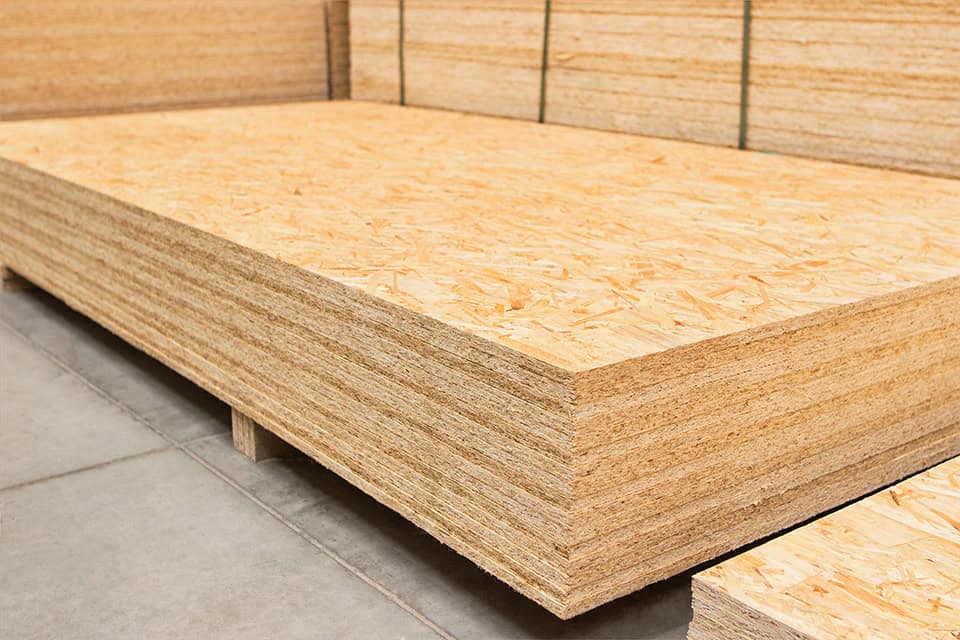

What is OSB’s role in sound control?
OSB plays a pivotal role in sound control in modern designs due to its structural characteristics. The arrangement of wood strands creates a layered structure, promoting effective sound absorption and dampening. This quality makes OSB a valuable material for spaces of any size to mitigate noise and enhance acoustic comfort.
The dense and rigid nature of OSB contributes to its ability to reduce sound transmission. When integrated into a wall, ceiling or floor to create OSB flooring, it acts as a sound barrier. This prevents the transfer of airborne and impact noise between spaces. Its strength also allows for the construction of robust and durable structures that further enhance sound control.
In addition, OSB brings a dual benefit by offering a sustainable and cost-effective alternative to alternative materials such as plywood. Designers and architects can leverage the acoustic advantages of OSB without compromising on aesthetics.
It can be seamlessly integrated into a variety of design styles. Whether used in residential construction or commercial buildings, OSB boards help you achieve optimal sound control.
10 key acoustic advantages of OSB boards
We explore the 10 advantages that OSB sheets bring to the table. From sound control to enhanced acoustics, discover how OSB plays an important role in creating spaces that deliver form and function.
1. Effective sound absorption
With its oriented wood strands, OSB’s unique structure creates a surface that excels in absorbing sound waves. This means that when used in interior spaces, OSB helps to reduce echoes and reverberation. As a result, it creates a more comfortable and acoustically pleasing environment.
2. Noise reduction across spaces
OSB's density acts as a barrier to both airborne and impact noise. Whether it is the hum of conversations or the impact of footsteps, OSB minimises the transmission of these noises. Therefore, it contributes to a quieter and more peaceful atmosphere between different rooms or floors.
3. Vibration damping
Beyond its role in airborne noise reduction, OSB's structural strength plays a crucial role in damping vibrations. This is particularly beneficial in spaces where structural noises, such as creaks and vibrations, can be disruptive. OSB helps maintain a quiet environment by absorbing and minimising these vibrations.
4. Privacy enhancement
OSB's ability to reduce sound transmission enhances privacy in spaces where confidentiality is essential. Offices or any area requiring a degree of seclusion can benefit from OSB's contribution to creating a more private and isolated acoustic environment.
5. Versatile uses for sound control
One of OSB's standout features is its versatility. It can be seamlessly integrated into a wall, subfloor, loft or ceiling to provide a solution for comprehensive sound control throughout a building. This adaptability makes OSB a valuable asset in various architectural elements.
6. Cost-efficient acoustic solution
For sound control, OSB sheets stand out as a cost-effective alternative. It offers high acoustic performance without burdening the project with excessive costs. OSB is an efficient choice if you are aiming to balance performance and budget.
7. Sustainable acoustics
OSB's sustainability is a key advantage in the modern architectural landscape. Derived from renewable wood sources and manufactured using eco-friendly processes, OSB aligns with green building practices. This makes it not only an acoustic solution but also a sustainable choice for environmentally conscious projects.
8. Compatibility with other materials
Generally, OSB's compatibility with other building materials is a significant advantage. It easily combines with materials like drywall or insulation, creating systems which enhance overall sound control. This compatibility provides architects and builders with flexibility in designing optimal acoustic solutions.
9. Long-term durability
OSB's durability ensures that its acoustic performance remains consistent over time. Unlike some materials that may degrade or lose effectiveness, OSB stands the test of time. It provides a reliable and enduring solution for sound control in modern designs.
10. Design flexibility with aesthetic appeal
Overall, OSB's adaptability allows architects and designers to achieve functional acoustic and aesthetic goals. From contemporary to traditional designs, OSB can be seamlessly integrated. This adds a visual appeal to spaces while concurrently enhancing acoustic quality.
Is OSB better than plywood for soundproofing?
Both OSB and plywood can be used for soundproofing. However, the choice between OSB vs plywood depends on various factors, with neither being superior. The density of OSB tends to be higher than that of plywood, potentially contributing to its effectiveness in reducing sound transmission.
Also, OSB offers structural strength with uniformity and consistency. This is beneficial for maintaining a stable and soundproof structure.
However, plywood generally exhibits better moisture resistance. The choice between the two may also hinge on installation preferences, with both OSB and plywood being relatively easy to install. Plywood is often favoured for its aesthetic appeal, especially where a natural wood finish is desired.
If design flexibility and the visual aspect are priorities, plywood might be the preferred choice.
How to combine OSB with acoustic insulation
Here are 9 top tips for a seamless OSB boards installation without compromising durability and design. By following these tips, you can achieve structural integrity and superior sound control within any space.
1. Strategic material placement
Identify key sound-sensitive areas and strategically use OSB sheets. This can include walls and ceilings or create an OSB floor with a targeted sound barrier without compromising on design.
2. Layering techniques
Consider using OSB in combination with other soundproofing materials. For example, you can use acoustic insulation or drywall to create a layered approach for enhanced sound control
3. Precise installation practices
Ensure precise installation of OSB sheets, paying attention to tight joints and proper fastening. A well-installed OSB layer contributes to its effectiveness in reducing sound transmission.
4. Seamless integration with finish
Plan for the integration of finishes, such as paint, wallpaper, or panelling. You should ensure that the final design seamlessly conceals the OSB layer. This allows for a cohesive and visually appealing look.
5. Customised cutouts for fixtures
When incorporating OSB in ceilings or walls, create customised cutouts for fixtures such as lights or outlets. It ensures that the design remains functional while maintaining the soundproofing integrity.
6. Consideration of thickness
Select the appropriate thickness of OSB based on the specific sound control requirements of the project. Thick OSB sheets may be needed in areas where higher sound reduction is crucial.
7. Collaboration with soundproofing experts
If you are unsure about anything, collaborate with soundproofing experts during the design stage. This will help to optimise the integration of OSB sheets with other soundproofing elements.
8. Incorporate design elements
Explore creative ways to incorporate OSB as a design element. Exposed OSB in certain areas can add an industrial or contemporary aesthetic, contributing to the overall design vision.
9. Test and evaluate performance
Before finalising the design, conduct tests to evaluate the acoustic performance of the integrated OSB soundproofing system. This allows for adjustments to achieve the best results.
Can you minimise noise levels with OSB for roofing?
The strategic placement of OSB holds the key to effective sound control. Explore how the following considerations make OSB sheets an important material in minimising sound transmission.
Layered construction for mass
Opt for a multi-layer approach with OSB sheets in the roofing structure. This involves using multiple layers of OSB, which adds mass to the roof assembly. Increased mass helps in dampening airborne noises, such as rainfall or external traffic sounds. Thicker OSB panels inherently provide better mass and sound reduction.
Combination with acoustic insulation
Pair tongue and groove OSB with sound-absorbing insulation materials within the roofing assembly. Insulation materials like mineral wool or fibreglass can absorb sound waves. This provides an additional layer of sound control for an effective insulated OSB board.
Tight joints and sealing gaps
Ensure that the joints between OSB sheets are tightly secured, and any gaps are meticulously sealed. This prevents the escape of sound waves and enhances the overall effectiveness of OSB in minimising sound transmission.
Acoustic underlay beneath OSB
Install an acoustic underlay beneath the OSB layer. This underlayment is specifically designed for sound control, adding an extra barrier against both impact and airborne noise transmission.
Combination with specialised roofing materials
Combine OSB with specialised roofing materials designed for soundproofing. This may include acoustic membranes or OSB sheathing that complement its sound reduction properties.
Addressing impact noise
Leverage the structural strength of OSB to minimise impact noise. For roofs subject to foot traffic or other sources of impact, the robust nature of OSB helps reduce the transmission of noise caused by such impacts.
OSB vs chipboard: Which is better for design and sound control?
Both come with their advantages and disadvantages. The choice between OSB and chipboard sheets depends on specific design and sound control goals. OSB is often preferred for its structural strength and versatility in design.
However, for enhanced sound control, chipboard may offer better acoustic properties because it is denser. Here, we have outlined the pros and cons to help you make an informed decision.
OSB
| Aspect | Advantages | Disadvantages |
| Sound control | - Good structural integrity. - Can be enhanced with additional treatments and materials for improved sound control. |
- Limited inherent sound-absorbing properties. - Requires additional treatments for optimal results. |
| Design | - Versatile finishes with paint. - Can be used for contemporary design styles. |
- Natural variations in texture. - Limited to contemporary design preferences. |
Chipboard
| Aspect | Advantages | Disadvantages |
| Sound control | - Denser composition may offer better sound control. - Effective for reducing impact and airborne noise. |
- May be less structurally rigid than OSB. - Limited design versatility compared to OSB. |
| Design | - Smooth surface allows for various finish options. - Suitable for a range of styles, including traditional. |
- Potentially does not offer the same modern aesthetic as OSB. - Susceptible to moisture, affecting appearance. |
Top-quality acoustic OSB board solutions
Elevate your construction projects with a material that goes beyond structural strength, providing a seamless blend of form and function. The OSB boards we supply are engineered to minimise sound transmission, ensuring a tranquil and comfortable atmosphere. With fast UK delivery, you can trust us to deliver high-quality OSB sheet materials promptly.
Building Materials Nationwide is your gateway to convenience and quality. Open a trade account and enjoy access to our OSB board range at competitive trade prices. As a trade account holder, you also receive personalised one-on-one service from your dedicated trade account manager.
Sign up now or contact us below with your queries.
More like this
- Your Best Options for Stud Wall Insulation
- Loft Insulation Installation: Trade Tips and Common Mistakes
- Everything You Need to Know About Foam Board Insulation

